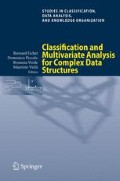Abstract
This paper aims to review some use of the point processes in cluster analysis. The homogeneous Poisson process is, in many ways, the simplest point process, and it plays a role in point process theory in most respects analogous to the normal distribution in the study of random variables. We first propose a statistical model for cluster analysis based on the homogeneous Poisson process. The clustering criterion is extracted from that model thanks to maximum likelihood estimation. It consists in minimizing the sum of the Lebesgue measures of the convex hulls of the clusters. We also present a generalization of that model to the non-stationary Poisson process, as well as some monothetic divisive clustering methods also based on the Poisson processes. On the other hand, it is usually considered that the central problem of cluster validation is the determination of the best number of natural clusters. We present two likelihood ratio tests for the number of clusters based on the Poisson processes. Most of these clustering methods and tests for the number of clusters have been extended to symbolic data.
Access this chapter
Tax calculation will be finalised at checkout
Purchases are for personal use only
Preview
Unable to display preview. Download preview PDF.
References
Bock, H.-H., Diday, E. (eds.): Analysis of Symbolic Data, Exploratory Methods for Extracting Statistical Information from Complex Data. Studies in Classification, Data Analysis and Knowledge Organisation. Springer, Heidelberg (2000).
Breiman, L., Friedman, J.H., Olshen, R.A., Stone, C.J.: Classification and Regression Trees. Wadsworth, Monterey, CA (1984).
Cox, D.R., Isham, V.: Point Processes. Chapman and Hall, London (1980)
Deheuvels, P., Einmahl, J.H.J., Mason, D.M.: The almost sure behavior of maximal and minimal multivariate kn-spacings. J. Multivar. Anal. 24, 155–176.
Diday, E., Noirhomme-Fraiture, M. (eds.): Symbolic Data Analysis and the Sodas Software. Wiley, Chichester (2008)
Fisher, L., Van Ness, J.W.: Admissible clustering procedure. Biometrika 58(1), pp. 91–104 (1971)
Hardy, A.: Statistique et classification automatique: un modèle, un nouveau critère, des algorithmes, des applications. PhD thesis, University of Namur, Namur, Belgium (1983).
Hardy, A.: A heuristic approach for the hypervolumes method in cluster analysis. Jorbel 36(1), 43–55 (1996)
Hardy, A.: On the number of clusters. Comput. Stat. Data Anal. 23(1), 83–96 (1996)
Hardy, A.: Validation of a clustering structure: determination of the number of clusters. In: Diday, E., Noirhomme-Fraiture, M. (eds.) Symbolic Data Analysis and the Sodas Software, pp. 235–262. Wiley, Chichester (2008)
Hardy, A., Beauthier, C.: Comparaison entre le test des Hypervolumes et le Gap test. Research report. University of Namur, Namur, Belgium (2004)
Hardy, A., Blasutig, L.: Application des tests de permutation au critère des Hypervolumes en classification automatique. Research report. University of Namur, Namur, Belgium (2007)
Hardy, A., Rasson, J.P.: Une nouvelle approche des problèmes de classification automatique. Stat. Anal. Donnèes 7(2), 41–56 (1982)
Janson, S.: Random coverings in several dimensions. Acta Math. 156, 83–118 (1986)
Kubushishi, T.: On some Applications of Point Process Theory in Cluster Analysis and Pattern Recognition. PhD thesis, University of Namur, Namur, Belgium (1996)
Milligan, G.W., Cooper, M.C.: An examination of procedures for determining the number of clusters in a data set. Psychometrika 50(2), pp. 159–179 (1985)
Moore, M.: On the estimation of a convex set. Ann. Stat. 12, 1090–1099 (1984)
Pirçon, J.-Y.: La classification et les processus de Poisson pour de nouvelles méthodes monothétiques de partitionnement. PhD thesis, University of Namur, Namur, Belgium (2004)
Rasson, J.P., Granville, V.: Geometrical tools in classification Comput. Stat. Data Anal. 23, 105–123 (1996)
Rasson, J.P., Kubushishi, T.: The gap test: an optimal method for determining the number of natural classes in cluster analysis. In: Diday, E. et al. (eds.) New approaches in classification and data analysis, pp. 186–193. Springer, Paris (1994)
Rasson, J.P. et al.: Unsupervised divisive classification. In: Diday, E., Noirhomme, M. (eds.) Symbolic Data Analysis and the Sodas Software. Wiley, Chichester (2008)
Ripley, B.D., Rasson, J.P.: Finding the edge of a Poisson forest. J. Appl. Probab. 14, 483–491 (1977)
Silverman, B.W.: Using kernel density estimates to investigate multimodality. J. R. Stat. Soc. Ser. B 43, 97–99 (1981)
Silverman, B.W.: Density estimation for statistics and data analysis. Chapman and Hall, London (1986)
Author information
Authors and Affiliations
Corresponding author
Editor information
Editors and Affiliations
Rights and permissions
Copyright information
© 2011 Springer-Verlag Berlin Heidelberg
About this paper
Cite this paper
Hardy, A. (2011). The Poisson Processes in Cluster Analysis. In: Fichet, B., Piccolo, D., Verde, R., Vichi, M. (eds) Classification and Multivariate Analysis for Complex Data Structures. Studies in Classification, Data Analysis, and Knowledge Organization. Springer, Berlin, Heidelberg. https://doi.org/10.1007/978-3-642-13312-1_5
Download citation
DOI: https://doi.org/10.1007/978-3-642-13312-1_5
Published:
Publisher Name: Springer, Berlin, Heidelberg
Print ISBN: 978-3-642-13311-4
Online ISBN: 978-3-642-13312-1
eBook Packages: Mathematics and StatisticsMathematics and Statistics (R0)

